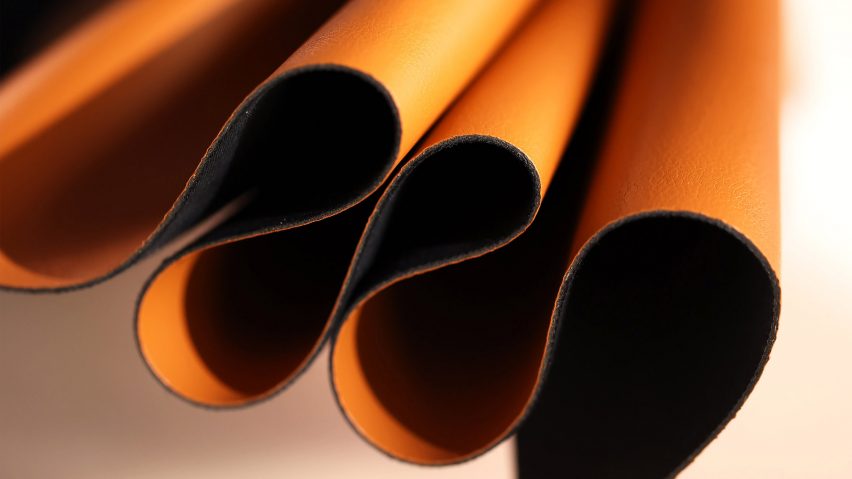Copenhagen-based Beyond Leather has combined leftovers from apple juice and cider production with natural rubber to create a plant-based leather alternative called Leap.
The animal hide substitute is made by mixing apple waste with natural rubber and applying it to a textile backing made of cotton and wood fibre before finishing it with a protective coating, creating a three-layered structure that can be disassembled at the end of its life.
Leap joins a growing cohort of biomaterials that are being designed to mitigate the environmental impact of animal leather and its plastic alternatives.
Among them are Piñatex, which is made from waste pineapple leaves and has previously been turned into Hugo Boss trainers, as well as the mushroom leathers being piloted by Adidas, Stella McCartney and Hermès.
Beyond Leather's apple-based version emits 85 per cent less CO2 in its production than traditional leather, according to the company's estimates, as well as requiring one per cent of the amount of water. A full lifecycle assessment is yet to be undertaken.
Leap is made from the skins, cores, stems and seeds of apples, which are left over after the fruit is juiced.
"Roughly 25 per cent of an apple goes to waste after pressing it for juice or cider," Beyond Leather co-founder Hannah Michaud told Dezeen.
"We source the apple waste for Leap from a small Danish juice producer who processes local farmers' apples into beverages and creates 500 to 600 tons of waste every year."
According to Michaud, this biomass helps to give the final material a supple yet robust finish much like real leather.
"The apple waste has a very high content of short fibres and polymers that, if used in the right way, can be activated to give the necessary strength and stiffness to the final material," she explained.
"Apple makes up the majority of our product and in the future we want it to make up the entire product."
At the moment, Leap uses a twill backing woven from certified organic cotton and Tencel, a kind of fibre made from wood pulp.
And, like many plant-based leather alternatives such as Piñatex, Leap's durability is currently ensured with the help of a protective plastic coating, which is embossed for texture and also contains the pigments that give the leather alternative its colour.
The coating was made half from traditional petroleum-based polyurethane and polyether, and half bioplastic.
Beyond Leather hopes to make the material completely bio-based and biodegradable by 2024.
"We aim to replace the current coating in a way that can still deliver the desired qualities without the use of fossil fuel-derived plastic, based on the company's philosophy of using waste as a core ingredient," Michaud explained.
In the meantime, the version of the material that will be made available to fashion brands this year was designed to be taken apart, so that its constituent materials can be separately recycled.
"The point of the three-layered design is that the fossil fuel-derived coating and the textile can be removed at the end of life of the final product," said Michaud.
"They can be put into their respective recycling loops while the apple itself can biodegrade."
Footwear brand Allbirds recently collaborated with materials startup Natural Fiber Welding to create what it claims is the first plant-based leather alternative to be made entirely without petroleum while producing 98 per cent fewer carbon emissions than animal hide.
Speaking to Dezeen as part of our carbon revolution series, Allbirds sustainability head Hana Kajimura explained that the reason the performance of biomaterials has so far been lagging behind that of fossil plastics is due to the fact that they have not received the same amount of funding.
"We lament how natural materials maybe don't perform as well as synthetics but this is just because of the lack of investment and innovation in this space," she explained.
"We've been innovating on synthetics for decades, since the 1800s when we discovered and started drilling for oil. And we just haven't placed that same amount of investment on natural materials and really figuring out how to increase their performance."

